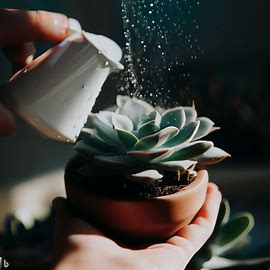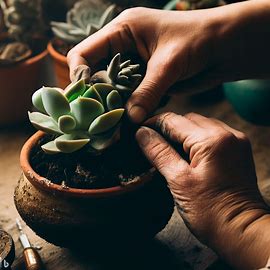Succulents are the divas of the plant world. They have a natural flair for survival and thrive on minimal care but, just like any true superstar, they can be rather finicky when it comes to water requirements. Overwatering is their nemesis and can quickly turn your succulent from a radiant beauty into a wilting damsel.
But hold up! It’s not time for a tearful goodbye yet; we’re swooping in with some practical advice on how to save overwatered succulents. Armed with these tips I’m about to share, you’ll transform from an anxious gardener into a confident “succulent savior”.
As you delve further into this post (believe me), you’ll discover more than just rescue missions—you’ll learn preventive measures too! So sit tight as we reveal the secrets of reviving those cute little desert dwellers who’ve had too much H2O.
Identifying the Signs of an Overwatered Succulent

Overwatering can be a common mistake when caring for succulents. These resilient plants are adapted to survive in dry conditions and do not require excessive watering.
It’s important to recognize the signs of overwatering so that you can take immediate action.
One of the first signs of an overwatered succulent is yellowing or wilting leaves.
The leaves may also feel soft and mushy, indicating that they have absorbed too much water.
Another sign is root rot, which can be identified by brown or black roots that appear slimy or foul-smelling.
Steps to Stop Watering and Dry Out the Succulent

To save your overwatered succulent, it’s crucial to stop watering immediately and allow it to dry out. Follow these steps:
1. Remove the plant from its pot: Gently remove the succulent from its pot using caution not to damage any delicate roots.
2. Remove excess water: Shake off any visible excess water from both the plant and soil surface.
3. Lay out on absorbent material: Place your succulent on a towel or paper towel to absorb extra moisture.
4. Trim off rotting parts: Carefully examine the succulent and trim off any rotting or mushy parts using clean, sterilized scissors or pruning shears. Make sure to cut slightly above the healthy tissue to prevent further damage.
5. Let it breathe: Allow the succulent to sit in a dry, well-ventilated area for a few days. This will help the roots and the plant itself to dry out completely.
6. Test the soil: After a few days, gently touch the soil with your finger to check for dryness. If it feels dry about an inch below the surface, it’s time to move the succulent back to its pot. If not, give it more time to dry.
Repotting and Recovery

1. Choose a suitable pot: If the succulent’s original pot doesn’t provide proper drainage, consider repotting it into a container with drainage holes to prevent future overwatering issues.
2. Prepare the soil: Use a well-draining succulent or cactus potting mix. You can enhance drainage by adding perlite or coarse sand to the mix.
3. Plant the succulent: Gently place the succulent in the new pot, making sure the roots are positioned properly. Fill in with the prepared soil and lightly press down.
4. Avoid watering immediately: It’s important to refrain from watering the succulent right after repotting. Wait about a week to allow any potential root damage to heal and callus.
5. Gradually reintroduce watering: Once the waiting period is over, start watering the succulent sparingly. Be sure to water the soil directly and avoid getting water on the leaves.
Preventive Measures for the Future
Now that you’ve successfully rescued your overwatered succulent, it’s time to learn how to prevent this situation from happening again:
1. Research the specific type of succulent you have and learn about its water requirements. Different species have different preferences.
2. Plant your succulent in soil that promotes good drainage. This will help prevent water from pooling around the roots.
3. Opt for pots with drainage holes to ensure excess water can escape, reducing the risk of overwatering.
4. Develop a consistent watering schedule based on your succulent’s needs and the surrounding environment. Always check the soil’s moisture level before watering.
5. Adjust your watering frequency based on the weather conditions. Succulents may need less water during cooler or humid periods.
Conclusion
By following these steps and preventive measures, you’re well on your way to becoming a savvy succulent caregiver.
Remember, a little extra attention to your succulent’s water intake can go a long way in ensuring their vibrant and flourishing beauty.
